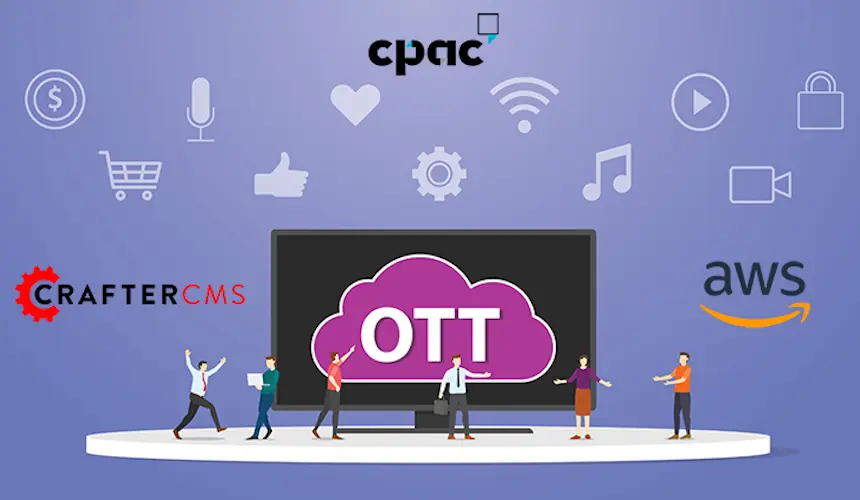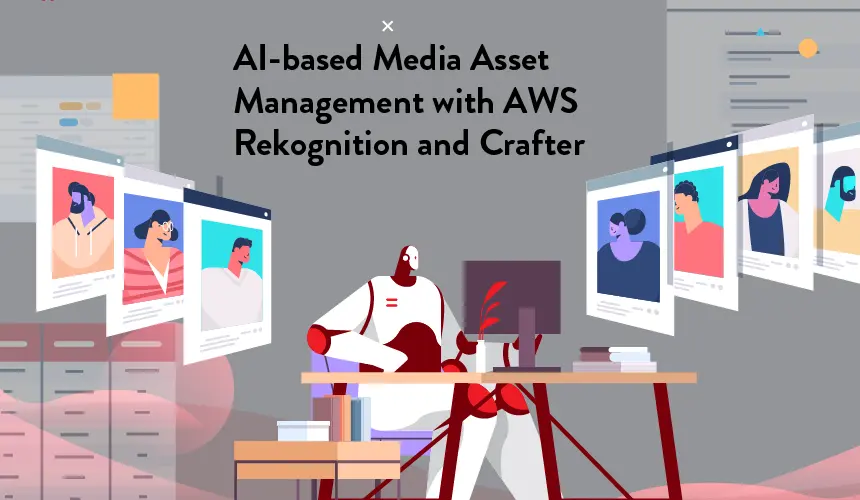Headless CMS Use Case: OTT Video for Media and Entertainment

Amanda Jones

Today’s leading media and entertainment companies have been forced to upgrade their existing systems to provide customers with the high-quality digital experiences they desire.
Platforms like Netflix, which reported around 222 million paid memberships in Q4 of 2021, have conditioned consumers to expect on-demand streaming content at their fingertips in multiple languages. Also, social media platforms like Facebook, YouTube, and others have changed the game regarding live streaming content and digital experiences.
A headless CMS that provides first-class support for OTT video streaming can be the greatest ally for brands that want to meet the changing customer needs brought about by these platforms. This article will showcase what modern media-focused companies need from their platforms and how CrafterCMS caters to these needs with modern video delivery and content management capabilities.
The State of Modern Media and Entertainment Companies
From news companies to newspapers, today’s media companies have had to shift their approach to content management and video delivery. With new technologies impacting customer preferences every year, modernizing existing systems and processes is crucial to providing an engaging experience.
Digital channels have become the medium of choice for content publication to meet the demands of today’s consumers, who prefer podcasts, OTT streaming, smart TVs and mobile apps for consuming content.
For example, the Cable Public Affairs Channel (CPAC) provides a window into Parliament, politics, and public affairs in Canada and worldwide. However, to be successful with this in the modern era, they need to incorporate an approach that includes:
- 24/7 live stream simulcast of the CPAC linear TV channel, available with closed captioning, three languages, and schedule information.
- Live and on-demand video of various parliamentary and political proceedings and committees, with closed captioning and three language tracks.
- Search descriptive metadata in multiple languages.
- In parallel, live streaming and video archiving of content assets on a YouTube channel and selected events on Twitter.
Modern Video Delivery and Content Management Requirements
Media companies such as CPAC can’t afford to be hampered by legacy infrastructure if they want to deliver the experience their customers demand. Some of the requirements of a modern media company include:
A Better Video Experience
Higher quality live streams and VOD, expanded encoding ladder with higher bit rate and resolution as well as live to VOD and improved DVR experience.
Enhanced Site Features
Improved search capabilities and the ability to meet accessibility standards such as WCAG2 Level AA.
Video Player Options
Improved player functionality that includes language track selection, video quality selection, and picture-in-picture.
For CPAC, in particular, when they needed to upgrade their existing infrastructure, they sought a platform to help them with operator pain points in current workflows. This included simplifying operational tasks, offering multi-language support, and improving monitoring.
However, fitting these requirements could only be possible with a scalable bespoke solution. For CPAC, and most media companies seeking to modernize their offerings, there is no one-size-fits-all solution that could satisfy them.
Media and entertainment organizations need to be able to build tailor-made digital team operations that provide cloud hosting options and the ability to work remotely in the distributed environment to which many employees have become accustomed. In addition, they need to be able to count on improved site reliability, near real-time data synchronization and publishing, better security and access controls without third-party plugins, and improved version control.
How a Headless CMS Should Support Digital Distribution Workflows
Adopting a headless CMS provides several benefits for media and entertainment companies, including increased flexibility due to an API-first architecture that supports content delivery to various channels. It also provides the speed to deliver digital experiences without negatively impacting internal workflows and the scalability to support a high volume of content creation. Here are some of the ways a headless CMS with first-class support for OTT video can enable media and entertainment innovators to accomplish their live video streaming objectives:
Headless Content Management
A cloud-native, decoupled headless CMS offers an API-first platform that is both extensible and scalable. This provides the freedom for developers to use any frontend development framework and the best tools for each job, whether React, Angular, Vue, or another framework of their choice.
Platforms like CrafterCMS also offer a Git-based content repository that provides advanced versioning, auditing, history tracking, branching, DevContentOps and support for continuous integration, development, and publishing (CI/CD/CP) for media and entertainment companies.
Live Event Stream Management
Live streaming remains a critical functionality that all media companies will need from a CMS. A headless CMS provides the ability to manage, monitor, and control numerous live streaming events by a single operator through easy integrations with event streaming software. Media organizations can stream playlist controls, including scheduled and manual slate control, audio channel reshuffling, and language code assignments.
For example, CPAC can count on multilingual data entry with customizable fields, including entering English and French metadata on the same page. They have access to stream monitoring, can integrate with web encoding solutions or orchestration systems, and have their entire infrastructure in the cloud.
Cloud Hosted Editing and Real-Time Content Publishing
Additionally, and most importantly, a headless CMS enables cloud-hosted editing and content publishing. This includes relatively basic editing of cloud-hosted VOD assets, including frame-accurate clipping using time of day captured with recording, the ability for manual time code entry or drag markers, and more.
Users can listen to any of the 3 language tracks and choose which ones they want to keep, leverage closed caption retention during the editing process, and create sidecar files (i.e., VTT). In the case of CPAC, this also meant publishing to the primary website or social media.
Modernizing Video and Content Management Capabilities Using CrafterCMS
Migrating from a legacy CMS and several disjointed services and processes might seem daunting for any media company. However, moving to a headless CMS can be crucial to modernizing video and content management capabilities in the modern era.
CPAC achieved this and now runs on a well-integrated solution built using CrafterCMS and AWS. CrafterCMS offers a headless “plus” solution that provides everything CPAC requires for their content management needs. With a selection of commercial offerings ranging from self-hosted/self-managed on any private or public cloud infrastructure, to fully-managed SaaS/PaaS, CrafterCMS allows media companies to choose what’s best for them. CPAC selected to run on Crafter Cloud – CrafterCMS’s fully managed SaaS/PaaS hosted on AWS.
CPAC also opted for CrafterCMS because they wanted complete visibility into its open source code base and the excellent online documentation. They chose React as a modern development framework due to its easy-to-build, highly functional, modern, user-friendly experiences. Content can be repurposed on the website and leveraged for new projects. The decoupled architecture allows the scaling of the content delivery components, increased security, and the ability to take the authoring platform down for upgrades without affecting public-facing sites.
They also have transparency over backend processes. Now a single log shows how and when items are getting synchronized and when items are published. CrafterCMS’ Git-based repository aligns with the versioning and branching requirements for both authors and the developers and their agile development and CI/CD processes. This helps with faster growth and rollout of features when and where needed to improve the viewer experience. Plus, AWS in the cloud makes the environment easy to manage, secure and scalable.
Discover more about how media companies can benefit from a headless CMS by watching this Recorded Webinar: Modernizing Video Delivery and Content Management at CPAC.
Related Posts

Websites Are Dead?

Mike Vertal

No-Code Experience Building for Marketers & Designers

Amanda Lee

Is Your CMS MACH-Ready? A Practical Guide for Enterprise Architects

Sara Williams

Composable DXP vs Traditional DXP: Why Enterprises Choose CrafterCMS

Amanda Jones
Related Resources
-

CrafterCMS at eBay: The Universal Content Platform for eBay.com
Webcast
-

Personalized Digital Experiences for a Cruise Liner
Webcast
-

Introducing CrafterCMS v4.0
Webcast
-

Modernizing Video Delivery and Content Management at CPAC, A Canadian Nationwide Broadcaster
Webcast
-

AI-based Media Asset Management with AWS Rekognition and CrafterCMS
Webcast





